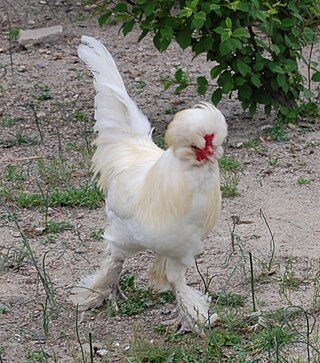Top Qs
Timeline
Chat
Perspective
Sultan chicken
Breed of chicken From Wikipedia, the free encyclopedia
Remove ads
The Sultan is a Turkish breed of crested chicken. The name derives from the original Turkish language name of Sarai-Tavuk, which translates as "fowls of the palace".[1]: 159 They have always been primarily ornamental, having been kept in the gardens of Ottoman sultanate.[1]: 159 In the West they are bred for competitive showing as part of poultry fancy, and are generally a rare sight.[2]: 173
The breed was first exported from its native country in 1854, when a Ms. Elizabeth Watts of Hampstead, London brought a small flock to Britain.[2]: 173 It was seen in North America by 1867, and was recognized officially by acceptance into the American Poultry Association's Standard of Perfection in 1874.[1]: 159
Sultans have a great deal of decorative plumage, including large, puffy crests, beards, long tails, and profuse foot feathering. Their small, V-shaped combs are almost entirely hidden under feathering. Sultans are also one of a minority of breeds to have five toes on each foot.[2]: 173 With males weighing approximately 2.7 kilos (6 pounds) and hens 2 kilos (4 pounds), they are the smallest of the large breeds of chickens. They also have a bantam version.
Sultans appear in three varieties: black, blue, and white,[1]: 160 with white being the most well known.[3]: 65 Hens lay small white eggs at a slow rate, and do not generally go broody.
Remove ads
References
Wikiwand - on
Seamless Wikipedia browsing. On steroids.
Remove ads

